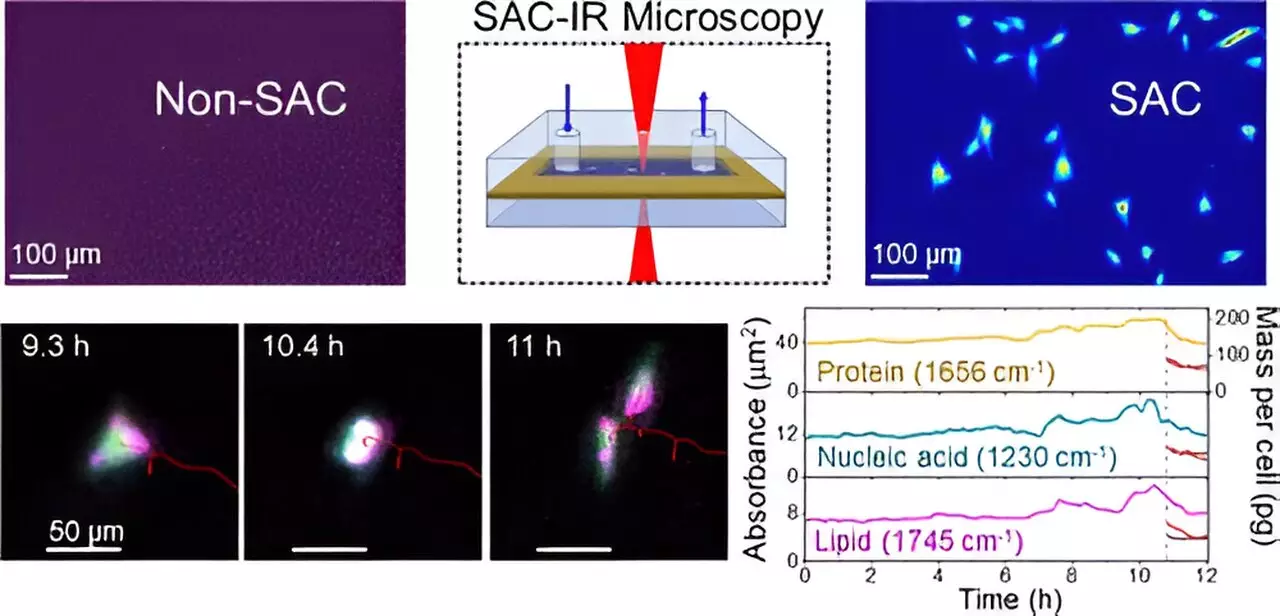Biotechnology is on the brink of a transformative era, driven by the urgent need for innovative drug therapies and advanced cell treatments. One of the major challenges has been the inability to observe biomolecules in living cells with sufficient speed and quantitative accuracy. The reason for this limitation lies in the complex relationship between biological samples and the investigative techniques used to observe them. Specifically, water—the predominant molecule in biological tissues—poses a unique dilemma. Its strong infrared (IR) absorption tends to obscure the crucial information being sought about other biomolecules like proteins and lipids, which are fundamental to understanding cellular functions.
Researchers at the National Institute of Standards and Technology (NIST) have made a pivotal advancement in solving this problem. By harnessing the capabilities of infrared microscopy, they have developed a novel approach that mitigates the impact of water absorption, thereby unlocking the potential for clearer imaging of biomolecules within living cells. This breakthrough offers a glimpse into a future where biomanufacturing, drug development, and personalized medicine can progress at an unprecedented pace.
Conventional IR techniques often grapple with discerning the ‘fingerprints’ of biomolecules due to the overwhelming background noise created by water. To tackle this issue, NIST chemist Young Jong Lee formulated the patented Solvent Absorption Compensation (SAC) method. Think of it as a specialized filter that allows researchers to ‘uncloak’ water absorption, revealing the spectrums of proteins and other essential biomolecules.
In practical application, the SAC technique was implemented using a customized IR laser microscope, specifically aimed at fibroblast cells, known for their role in forming connective tissue. The 12-hour imaging session conducted by NIST researchers succeeded in identifying pivotal biomolecular groups at distinct stages of the cell cycle, including during cell division—highlighting both the time-efficient nature of this method compared to traditional approaches and its unprecedented accuracy.
Additionally, the SAC-IR method is a label-free approach, meaning it avoids the use of dyes or fluorescent markers that might otherwise compromise the integrity of the cells and introduce variability in results derived from different laboratories. This aspect not only enhances the reliability of the measurements but also broadens the method’s applicability across diverse fields such as biomedicine and biological research.
The implications of the SAC-IR technique extend far beyond mere imaging. In a practical scenario like cancer immunotherapy, where immune cells are engineered to target and eradicate tumors, it becomes imperative to assess the altered cells’ safety and effectiveness. The insights gained from the new method could provide a deeper understanding of biomolecular changes, and therefore, cell health, equipping clinicians with the tools necessary for better treatment decisions.
Moreover, the method heralds exciting prospects for drug development processes. By facilitating the quantification of biomolecules in individual cells, researchers can conduct refined assessments regarding the effectiveness and safety of pharmacological agents. Whether testing new chemical compounds for a desired therapeutic effect or understanding how varying cell types might respond to particular drugs, SAC-IR paves the way for significant advancements in preclinical and clinical testing protocols.
As the NIST team looks to the future, there is hope to extend the technique to measure additional key biomolecules such as DNA and RNA. This prospective development could bridge existing gaps in fundamental cell biology research and enhance our understanding of cellular viability. For instance, the study of how certain biomolecular signatures indicate whether cells are alive, dying, or dead is crucial for optimizing protocols in cell preservation—especially considering the challenges posed by freezing and thawing.
The journey towards unlocking the secrets of living cells is fraught with challenges, primarily underscored by the difficulties in imaging biomolecules effectively. However, the advent of the SAC-IR method not only marks a significant milestone in overcoming these obstacles but also indicates a paradigm shift in cellular research methodologies.
The contributions of NIST’s innovative approach are poised to reshape areas concerned with drug discovery, biomanufacturing, and therapeutic development, laying the groundwork for improved patient outcomes and the customization of treatments. As researchers continue to optimize and expand the SAC technique, it is clear that we stand on the precipice of a new frontier in biotechnology, offering hope for breakthroughs that were once thought unimaginable. The path forward may not only enhance scientific understanding but also ultimately lead to saving lives through more effective drug therapies and targeted treatments.

